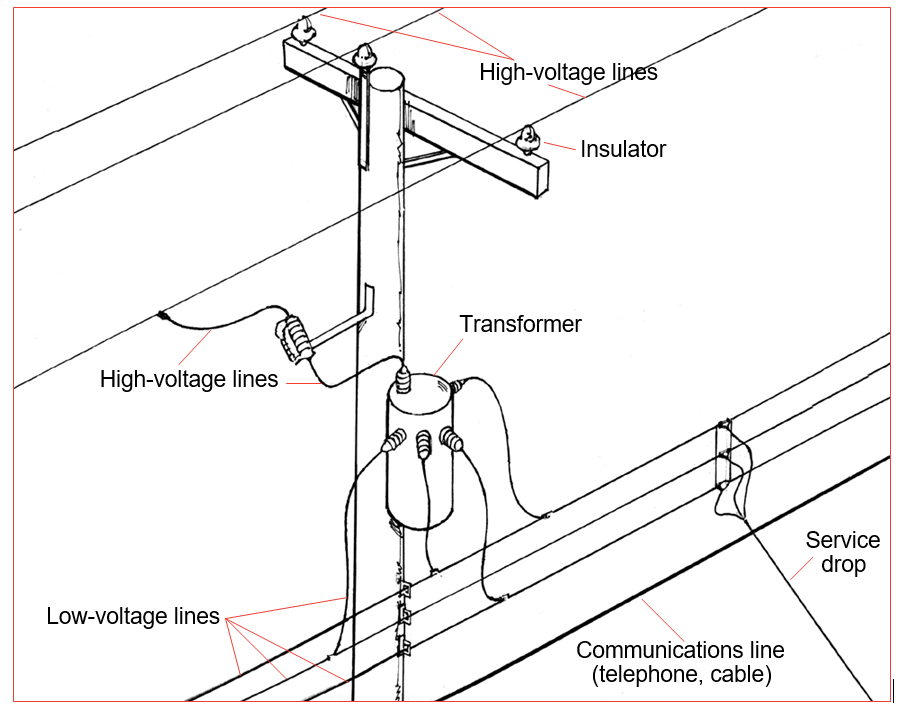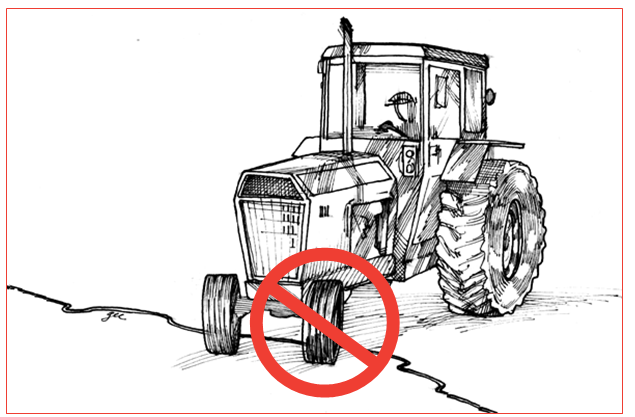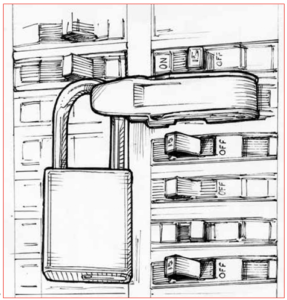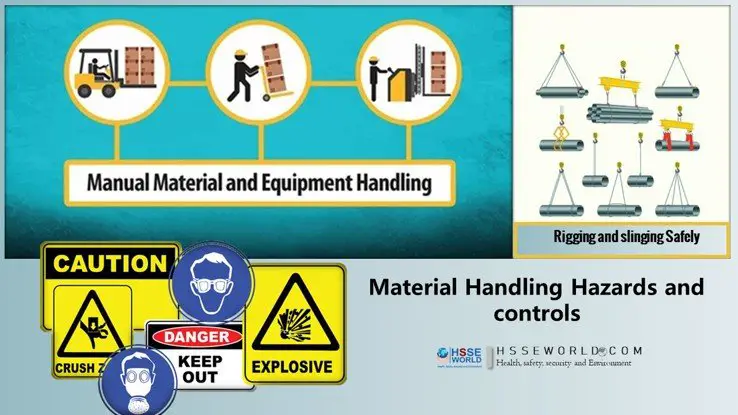Low-voltage electrical systems serve most homes and commercial buildings. Every day, hundreds of workers in many projects work safely on and around low-voltage electricity. Small or large, the job is usually handled without incident. Occasionally, however, something goes horribly wrong — an unexpected hazard is overlooked and a worker becomes the victim of a sudden explosion or a serious shock.
This part explains why energized low-voltage systems are dangerous and outlines the basic steps to de-energize and lock out equipment. This part also describes the hazards that are often overlooked when working on or around low-voltage systems. It tells you what to look for and how to avoid accidents.

Identifying low-voltage overhead conductors
Utility poles generally carry both low-voltage and high-voltage conductors (power lines), as well as communications lines, such as cable television and telephone. High-voltage conductors are always installed at or near the top of the utility pole. Low-voltage conductors are usually installed as single conductors mounted one above the other If there is a transformer on the pole, lines from the high-voltage conductors feed the transformer, which reduces the voltage for distribution through low-voltage lines to homes (120/240 V) and commercial and light industrial buildings (typically 347/600 V). Electricity travels through the low-voltage distribution lines to the service drop (located on the building), taking power to individual customers.
Employers are responsible for accurately determining the voltage of all power lines in the work area.

You can often identify overhead electrical conductors by their placement on the pole
Why energized low-voltage systems are dangerous
People often think that low-voltage contact is much less dangerous than high-voltage contact. They may believe that a mistake made while working on a low-voltage system means only a quick flash and the tripping of a circuit breaker. This is a common misunderstanding.
There are more injuries from low-voltage systems (especially 347 V systems) than there are from high-voltage systems. An electrical current through your heart can cause an irregular heartbeat or a heart attack.
Electric shock can also cause your muscles to contract and may prevent you from releasing your grip, thus extending your exposure to the current. In some instances, low voltage contact can cause serious shock and burn injuries and even death.
Two factors can make energized low-voltage equipment extremely hazardous. First, the small working clearances between low-voltage components leave little room for error when using tools.
Second, low-voltage equipment in some industrial services may be supplied by an electrical system that can feed incredible amounts of energy into a fault (caused by a short-circuit, for example). In such cases, a fault can cause an intense, persistent, and rapidly expanding arc of electrical energy to build in a split second. This energy is released suddenly in a restricted space. The flames can cause terrible burns on anyone within the arc’s range, which may reach up to 3 m (10 ft.). Arcs of this kind often leave the electrical structure a charred and melted wreck — stark evidence of the intense heat generated, which can be several thousand degrees.
Almost all voltages are potentially dangerous because of the shock hazard. With low voltages fed by high-capacity transformers, the danger of arc-flash burns is an additional hazard that can cause serious injuries.
As well as causing fire, the heat from an arc can melt solids, vaporize liquids, and expand gases. This results in a huge buildup of pressure, which causes an arc blast. The blast can throw workers across a room, destroy equipment, and hurl objects and pieces of metal onto nearby workers. In some tests, the noise from an arc blast reached 140 decibels.
Working near energized equipment
Uninsulated, energized parts of low-voltage electrical equipment and conductors must be guarded by approved cabinets or enclosures unless the energized parts are in a suitable room or enclosed area that is accessible only by qualified and authorized persons.
Each entrance to a room or other guarded location containing uninsulated and exposed energized parts must be marked with warning signs limiting entry.
If uninsulated, energized parts are not guarded with approved cabinets or enclosures:
- Suitable barriers or covers must be provided if a worker unfamiliar with the hazards is working within 1 m (3.3 ft.) of those parts or
- The worker must be informed of the potential hazards and must follow written safe work procedures

De-energization and lockout
Because of the hazards of working on energized low-voltage equipment, the first choice is to de-energize and lock out the equipment before doing maintenance work on it. De-energization and lockout prevents the release of energy that could cause injury or death. Locks are used to make sure no one accidentally turns on equipment while workers are performing maintenance on it.
Maintenance is any work that keeps machinery or equipment in a safe operating condition. This includes installing, repairing, cleaning, and lubricating equipment, as well as clearing obstructions to the normal flow of material.
As a worker, you must follow your employer’s safe work procedures to de-energize and lock out equipment. At a minimum, a procedure should include the following five steps:
- Identify the machinery or equipment that needs to be locked
- Shut off the machinery or equipment. Make sure all moving parts have come to a complete stop. Also make sure the act of shutting off equipment does not cause a hazard to other
- Identify and deactivate the main energy-isolating device (for example, a switch or valve) for each energy source. There may be more than one source of power, such as backfeed from the load side or control voltage from a separate
- Apply a personal lock to the energy-isolating device for each energy source. Ensure that all parts and attachments are secured against inadvertent movement. Each worker must apply a personal lock unless you are following a group lockout
- Test the lockout to make sure it’s effective and to verify that all live components have been de-energized. First, ensure that all workers are in the clear and that no hazard will be created if the lockout is not effective. You can test lockout after each energy-isolating device is locked out or after a group of nearby devices is locked

Apply a lock to the electrical disconnect switches before working on the equipment.
Safe work procedures for work on electrical equipment should include the following:
- Steps to ensure that all work has been completed on a circuit before it is connected to the power source
- Who is qualified to test electrical circuits
- What types of testing devices are acceptable
Working on energized equipment
For most work, you must de-energize electrical equipment because there is a high risk of injury when working on energized equipment. It may be possible to schedule such work outside of normal work hours to limit the inconvenience.
Sometimes it is not practicable to completely disconnect low-voltage equipment before working on it. For example, it may be necessary to have equipment running in order to test it or fine-tune it. In such cases, the work must be performed by workers who are qualified and authorized to do the work. They must follow written safe work procedures.
You should observe the following general precautions when working on energized equipment (but note that these are not a substitute for proper training and written safe work procedures):
- Think ahead. Assess all of the risks associated with the task. Plan the whole job in advance so you can take every precaution, including arranging for help in case of paralyzing shock. Consider holding
a pre-job safety meeting to discuss the job with all workers before starting the work.
- Know the Make sure accurate, up-to-date information is available to everyone working on the system.
- Limit the Expose live parts for as little time as necessary. This does not mean you should work hastily. Be organized so you can do the job efficiently.
- Cover exposed live Use insulating barriers or shields to cover live parts.
- Cover grounded metalwork. Cover grounded metal parts with insulating material as much as
- Limit the energy to reduce the Take all practical steps to ensure the fault current at the point of work is kept as low as possible while the work is in progress. For example, when measuring voltage, do it on the load side of the circuit-protective devices with the smallest current rating. Current-limiting devices can be used to reduce the risk of an arc flash.
- Remove metal rings, bracelets, and wristwatches. These could cause a short-circuit if there are small clearances. If it is necessary to wear MedicAlert bracelets, secure them with transparent surgical tape, adhesive tape, or rubber
- Use one hand and turn your face and body to the side when operating a safety Limit possible injuries by not placing body parts directly in front of energized equipment when there is danger of an arc flash.
- Avoid electrical contact when working in awkward positions. If you must work in an awkward or unbalanced position and reach with your tools, use insulating cover up material on the tools to avoid contact with live conductors.
- Use the correct equipment and See “Personal Protective Equipment and Clothing.”
Personal protective equipment and clothing
Employers are responsible for providing any specialized personal protective equipment and clothing necessary for work on energized equipment. Supervisors must ensure that workers use the clothing and equipment. Workers are responsible for inspecting the equipment before use and for using it properly.
When working on energized equipment, qualified and authorized workers need the following protective equipment and clothing:
- Insulated tools to avoid shocks and prevent accidental short-circuits
- Rubber gloves (or leather gloves for testing equipment)
- Cover-up blankets to avoid accidental contact with live equipment
- Shock-resistant safety boots or shoes (with appropriate CSA symbol)
- Safety glasses, goggles, or a face shield to protect against molten metal or ultraviolet light
- Flame-resistant clothing if there is a risk of an electric arc that could cause a fire
Safety glasses normally used on construction projects to protect against debris are not designed to prevent injuries from the ultraviolet light of an electric arc. If the risk is high, de-energizing must be the first choice. If work has to be done on live equipment, polycarbonate safety glasses are required; however, you should consider using a complete polycarbonate face shield. Polycarbonate glasses will filter out most of the ultraviolet light, and yellow tinted glasses will filter out more blue spectrum light without making it too dark to work. However, even the best safety glasses cannot protect against an electric arc or a fireball.

When working on energized low-voltage equipment, workers need protective equipment, including insulated tools, safety eyewear, rubber gloves, and shock-resistant footwear.
Flame-resistant clothing
If there is a fire hazard, workers must wear flame-resistant clothing. Consider wearing clothing made of flame-resistant cotton or wool blends. The fabric should have a smooth, tightly woven finish.
Avoid clothing made of nylon, polyester acetate, or acrylic fibres. These fabrics are moderately flammable and will melt while burning, causing deep and extensive burns to the skin. Workers should also avoid laminated fabric containing polyurethane sponge because it ignites and burns quickly. Many synthetic materials don’t char or ash when they reach ignition temperatures. Instead, they melt and form a hot, tacky residue that sticks to skin and burns the flesh.
HAZARD ALERT
A journeyman electrician was burned when there was an explosion caused by an electric arc. He was installing a 600 V temporary service to a construction site. The high-visibility vest he was wearing caught fire, and the plastic on the vest melted, increasing the severity of his burns. Although flame-resistant vests are available, most high-visibility vests are not flame-resistant. If there is any danger of a fire or explosion when working with energized equipment, workers should remove clothing that isn’t flame-resistant.
Common problem areas
This section highlights common problem areas and gives examples of actual incidents where workers have suffered injury while working on electrical equipment. It also offers suggestions to help you work safely.
Lighting circuits (347 volts)
With the increasing use of 347/600 V systems in commercial and industrial buildings, lighting at 347 V is common. De-energize and lock out the power supply before working on electrical components. Then test all conductors to ensure de-energization. Work must not be done on energized parts of electrical equipment connected with lighting circuits operating at more than 250 volts-to-ground without the prior written permission
Lockout is required at the electrical panel before replacing any part associated with the lighting circuit. When testing lighting circuits, prior written permission is not required as long as you follow established safe work procedures and use CSA-approved test equipment and tools.
HAZARD ALERT
A worker contacted an energized wire while working on an energized 347 V ballast box above the suspended ceiling. Using safe work procedures, a co-worker pulled him away from the paralyzing contact. Subsequently, one of the worker’s fingers had to be amputated. In another similar incident, a worker suffered electric shock and died.
Checking voltages with a meter
In order to check voltages with a meter, you must be qualified and know the hazards. Testing can be dangerous, particularly if someone is unqualified, with little or no electrical experience. For example, you must never use an improvised test lamp, which can cause an electric arc. If you incorrectly connect a meter to measure current rather than voltage, the low resistance of the ammeter could allow an abnormally high current to flow when voltage is checked.
Workers often lean close to equipment to see where to put the test probes. If an electric arc occurs, your face will bear the brunt of the intense heat. You must wear goggles or safety glasses. If there is a high risk, you must use a full-face shield. See page 11 for more information on safety glasses.

Use approved portable meters and leads, not improvised test lamps.
An electric arc may occur in one of the following ways:
- An improvised test probe (for example, a screwdriver blade or bare alligator clips) with more than the necessary exposed metal may create a phase-to-phase or phase-to-ground short-circuit on the closely spaced fuse clips or bus bars of a 600 V
- A screwdriver being used on energized equipment may slip and ground out the live
- A multimeter that is not switched from the ammeter or ohmmeter mode may create a short-circuit across phases when the probes are placed on the conductors to measure voltage. The multimeter may disintegrate if the internal fuse is not designed to protect against this kind of misuse. This, however, is not the worst that can
The arcing caused at the test probes can ionize the air, resulting in a fireball. This problem should not occur if testing equipment meets the requirements listed below.
The testing equipment must meet CSA standards or another standard acceptable to WorkSafeBC. Alternatively, acceptable testing equipment must have the following characteristics:
- It has high rupturing capacity fuses or alternative protective circuitry to protect you in case of a
- Measurement ranges are clearly and unambiguously
- The insulation on the instrument leads is in good condition and is rated to the maximum voltage reading of the
- The lead wires are not cracked or broken. They have a current carrying capacity (ampacity) that meets or exceeds the maximum current measurement of the
- There is only a minimum amount of exposed metal at the probe tips to avoid short-circuiting closely spaced live
When checking voltages with a meter, you must use an approved meter and should follow safe work practices, which include the following:
- Set the meter to the correct mode and voltage range. If possible, check its operation on a 120 V convenience outlet (for example, a system with a low available fault current). Multi-range instruments should always be turned off or set to their maximum AC voltage range when not in
- Use a single-function meter (voltmeter) rather than a multimeter, if possible.
- Where possible, test on the load side of the fuse or circuit breaker that has the smallest
- Make sure meter leads are connected to the appropriate terminals of the meter for the measurement
- Set the meter at the highest range that will allow for the expected reading to be
Working alone
Electrical work is often done by someone working alone or in isolation, such as on a rooftop or after regular hours so de-energization does not inconvenience as many workers.
The employer must develop and implement a written procedure for checking the well-being of a worker doing electrical work alone or in isolation. The procedure must include the time interval between checks and the procedure to follow in case the worker cannot be
contacted, including provisions for emergency rescue. Someone must be designated to establish contact with the worker at predetermined intervals and at the end of the work shift. The time intervals must be determined in consultation with the worker assigned to work alone or in isolation.
Storage batteries
Some batteries may have a high level of stored energy (for example, batteries in battery-powered vehicles or large banks of storage batteries). Short-circuiting by a ring or wristwatch bracelet can severely burn you, even if no shock hazard exists. The voltage of some battery banks, however, may be high enough to also be a shock hazard.
You must use proper protective equipment for testing, connecting, or disconnecting batteries. To protect against battery acid, use a face shield, plastic apron, and plastic gloves. There must be an eyewash station nearby in case of splashes to the eye. You must use insulated tools (for example, wrenches or screwdrivers).
HAZARD ALERT
A technician was installing a storage battery when his wristwatch contacted the battery terminal. The wristwatch caused the battery to short-circuit, and the worker suffered severe burns to his hands.
Ladders and other long tools or equipment
Workers must not use metal ladders, wire-reinforced wooden ladders, and other long tools or equipment, such as gutters or scaffolding, when working on energized electrical equipment or near energized
electrical equipment if there is a possibility of contacting bare energized components.
Low-voltage sections of unit substations
Workers have been injured while replacing components on low-voltage sections of unit substations. Unfortunately, this type of low-voltage section of the switch gear is often close to the supply transformer terminals — a place where there is very little impedance to limit the flow of fault current. If there are a number of loads on a bus bar, the supply transformer may be quite large. The larger the transformer,
the larger the current that will pour into a fault. Working on live installations of this kind can be extremely dangerous. De-energizing must be your first approach in such cases.
Some electrical equipment is designed to electrically isolate sections of the unit substations. You can maintain this equipment safely without
de-energizing all of it. Consult the manufacturer’s instructions and refer to written safe work procedures.
HAZARD ALERT
Two workers were attempting to add a new 400 A switch to the energized 600 V section of a 1,500 kVA power centre. A number of important loads were fed from the low-voltage bus bars where the workers were going to install a new fused switch. They didn’t want to inconvenience other operations by de-energizing the other loads connected to the bus bars. Instead of planning a shutdown, they decided to install the switch live because it was “only” low voltage. The workers were severely burned during the installation.
Working near low-voltage overhead lines
Individual buildings such as houses often receive low-voltage electricity from overhead distribution lines and service drops. These lines are usually out of reach. However, workers using a ladder may come
close to low-voltage lines — for example, when washing windows or painting. These lines are not insulated well enough for a person to touch them safely. Consider them energized and dangerous.
When a work process, such as window washing or painting, results in a temporary encroachment by a worker into the area of low-voltage lines, either of the following must occur:
- Barriers or covers must be provided if a worker unfamiliar with the hazards is working within 1 m (3.3 ft.) of those
- The worker must be informed of the potential hazards and must follow written safe work
Sometimes there may be a permanent change in the building, such as a new stairway or work platform, that allows workers to get near the
low-voltage lines. In this case, qualified and authorized workers must reposition or cover the lines with conduit or other approved cover to protect workers from contact.
Portable electrical equipment and extension cords
Portable electrical equipment must be checked to ensure it is approved. Portable power tools and extension cords must be maintained in good repair and be suitable for the conditions where they are being used. For example, the outer jacket of an extension cord may appear undamaged but may conceal a broken ground conductor. Portable electrical equipment must be effectively grounded unless it has double insulation or equivalent protection.
Additional precautions are needed if approved portable electrical equipment is used outdoors or in wet or damp locations. This equipment, including temporary lighting, requires a class A–type ground fault circuit interrupter (GFCI) installed at the receptacle or on the circuit panel unless another means of protection is provided that is acceptable, such as the Assured Grounding Program.
Workers have been electrocuted or badly burned as a result of contact with damaged extension cords. Electrical cords are often left unprotected, stretched across ground in the path of machinery. Over time, these cords become frayed, cut, and damaged from constant use and the pressure of vehicle traffic running over them.
Sometimes wires are left exposed or a cut cord is repaired only with electrical tape. These cords are particularly hazardous when the ground is wet.

Damaged cords can result in serious electrical injuries.
GFCIs and Assured Grounding Programs
A GFCI is a device that detects any leakage current in an electrical circuit and trips (turns off) the circuit whenever the leakage current is greater than 5 milliamperes. GFCIs are required whenever portable electrical equipment is used outdoors or in wet or damp locations.
Company allows use of an Assured Grounding Program as an alternative to using GFCIs in such conditions. However, the use of an Assured Grounding Program requires permission from the electrical authority that has jurisdiction in the area.
Using GFCIs
To prevent nuisance tripping of GFCIs, the following safe work practices are recommended:
- Mount GFCI receptacles and GFCI circuit breakers in dry If this is not possible, use portable GFCIs that are rated rainproof.
- Connect only one power tool to each
- Cover power tools to protect them from the rain when they are not in
- Store power tools and extension cords in a dry
- Maintain extension cords and power tools in good
- Use extension cords that are rated for hard usage or
- Don’t use extension cords longer than 45 m (150 ).
Assured Grounding Program
Before an Assured Grounding Program can be used instead of GFCIs, a variance must be obtained from the electrical authority having jurisdiction. The purpose of an Assured Grounding Program is to ensure that the black wires (hot), white wires (neutral), and, in particular, green wires (ground) of extension cords and power tool cords are properly connected. This is done by testing every extension cord and power tool when it is first put into service, following repairs, and every three months.
An Assured Grounding Program has four parts:
- Worker training — All workers using extension cords and power tools under an Assured Grounding Program must be trained on the
- Daily visual inspection — Extension cords and power tools must be checked for damage daily by the persons who will be using them. Any damage found must be repaired before the cord or tool is Damaged extension cords and power cords of tools must not be spliced. The cords can either be replaced or shortened to remove the damaged portion.
- Continuity and polarity testing every three months — A qualified worker must test every extension cord and power tool for circuit continuity and correct polarity before they are used for the first time, following repairs, and during the months of January, April, July, and A qualified worker is a person who has been authorized by a supervisor to perform the task and who has received appropriate training.
- Colour-coding extension cords and power tools — Extension cords and power tools that have been tested must be tagged with a coloured band about 10 cm (4 in.) from
the male plug. Coloured electrical tape is suitable for this purpose. A different colour is required for each quarter of the year. The following colours are standard for all worksites using an Assured Grounding Program in B.C.:
Red January, February, March
White April, May, June
Blue July, August, September
Green October, November, December
As an example, a new extension cord tested on February 8 will have a red tag at the male plug. The extension cord must be retested and marked with a white tag during April.




